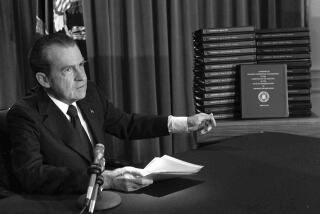As Office Lights Go Out, It’s <i> Deja Vu</i> : Bureaucracy: Federal agencies have been closed three times since 1981 because of lack of funds. If experience serves as guide, confusion could prevail.
- Share via
WASHINGTON — The lights began going out in government offices across America. The Statue of Liberty and the Washington Monument were closed. At the National Archives, workers lowered the Constitution and the Declaration of Independence into a deep vault until the crisis passed.
Throughout the country, several hundred thousand federal workers were dismissed and sent home.
That was nine years ago--the first time that the most powerful government in the Western world came to a virtual standstill because it ran out of operating funds during a budget stalemate between Congress and the President.
That scenario--repeated briefly in 1984 and 1986--could be replayed once more on Tuesday if the current budget deadlock is not resolved during the long Columbus Day holiday weekend.
And, if experience serves as a guide, a fair amount of confusion could prevail as department heads and supervisors throughout the federal bureaucracy scramble to figure out who to let go and who to keep behind to begin a full shutdown of the government.
o Under federal going-out-of-business orders, then, as now, essential personnel remain on the job. These include the military and some civilians at the Pentagon, law enforcement and medical personnel, air traffic controllers, Customs Service inspectors--and even tax collectors.
But dividing workers from non-workers is easier said than done. Even some of the agencies’ own spokesmen seem confused. The National Weather Service, which told inquirers on Friday that it would shut down service at night, said Saturday that it will continue operating 24 hours a day.
And while most agencies in 1981 arranged to keep their computers in operation and to continue many services--such as those affecting public health and national security--others shut down just about entirely.
For instance, the Food and Drug Administration conducted business as usual, but the Civil Aeronautics Board virtually stopped operating. The Environmental Protection Agency furloughed everyone except some emergency-response teams, including those involved in waste cleanups.
The Securities and Exchange Commission at first thought it would have to stop processing financial registration statements. Finally, after much high-level internal debate, the SEC decided it would continue business as usual.
Similarly, the Treasury Department also continued issuing short-term bills and its bureau of engraving and printing produced $125 million in paper money.
But at the White House, 220 employees--mostly secretaries and low-level workers--were sent home.
As in the current budget crisis, the shutdown in 1981 came after then-President Ronald Reagan vetoed an emergency spending resolution passed by Congress, triggering the nation’s first-ever federal government shutdown.
That early-morning veto on Nov. 23, 1981, produced chaos at the 40-story Jacob K. Javits Federal Building in New York, one of the largest federal offices outside of the nation’s Capital, with 10,000 workers.
When Immigration and Naturalization Service supervisors first made the furlough announcements over the loudspeakers just past noon, several hundred aliens were standing in line in the INS lobby, waiting to register.
But INS personnel quickly left the building. Minutes later, agency officials reversed themselves and said--again, over the loudspeaker--that the office would remain open.
By then it was too late. Most of the work force had already departed.
It wasn’t until nearly 7 p.m. that day that Reagan signed a new bill to keep the government functioning. Workers returned the next morning.
A congressional subcommittee later concluded that the shutdown cost the federal bureaucracy $85 million, mostly in wasted time--in part because all the employees eventually got paid, whether they worked or not.
The third and last shutdown before the current budget crisis occurred on Oct. 7, 1986. But, still, chaos reigned as scores of agencies were left to decide for themselves which employees are essential and which are not.
The Education Department sent home 99% of its workers, but the Commerce Department kept more than two-thirds of its 30,000 employees--while furloughing the analysts who prepared the gross national product reports. As a result, the GNP reports came out a day later.
And at the Office for Micronesian Status Negotiations, all five employees stayed at their desks, pondering the future of the island’s political status.
More to Read
Sign up for Essential California
The most important California stories and recommendations in your inbox every morning.
You may occasionally receive promotional content from the Los Angeles Times.










